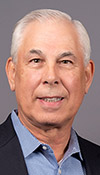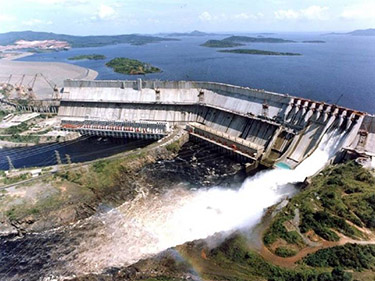|
Subscribe / Renew |
|
|
Contact Us |
|
| ► Subscribe to our Free Weekly Newsletter | |
| home | Welcome, sign in or click here to subscribe. | login |
Construction
| |
March 21, 2024
After over 50 years, Bob Adams is hanging up his hard hat at Atkinson
Construction Editor
This is no joke — Robert Adams will retire on April Fool's Day after 54 years at Guy F. Atkinson Construction.
In 2018, Adams told the DJC that he didn't know he would have such a long career in construction when he graduated from the University of Washington in 1970 with a degree in mechanical engineering. That article from 2018 covered his induction into the UW Construction Hall of Fame.
After graduating from college, Adams joined Atkinson and soon found a taste for large and challenging construction projects. His first assignment took him to Canada, where he helped finish Mica Dam, one of the largest earthfill dams in the world.

Mica Dam opened in 1973 and Adams was transferred to Southern California, where he worked for eight years on highway and marine projects, including outfalls for the San Onofre nuclear power plant. Adams put his mechanical engineering background to use here, designing equipment for dredging operations.
Adams' world travels weren't over just yet, as he was sent to Venezuela in 1981 to work on Guri Dam. Five years later, he returned to the U.S. to perform bridge estimating out of Atkinson's main office in San Francisco.
One of the estimating jobs handled by the San Francisco office was the Mercer Island lid over Interstate 90 (now called Aubrey Davis Park). Atkinson won that contract in 1989 but the project manager fell ill, so Adams temporarily moved back to the Northwest to fill in. He never left.
Adams found himself in charge of developing the company's Northwest Division in Renton, and was later promoted to his current title of senior vice president. A LinkedIn post by Atkinson Construction said, “Bob's strategic vision and technical expertise have been instrumental in advancing our heavy-civil operations in the Pacific Northwest.”
A sampling of Adams' local projects — totaling more than 100 — include improvements to Interstate 90 in the Snoqualmie Pass area, widening Interstate 405 in Bellevue, modifications to Mud Mountain Dam in Enumclaw, and a current job that involves corridor and interchange improvements to Interstate 5 between Everett and Marysville.
In addition to being inducted into the UW Construction Hall of Fame, Adams has filled his trophy case with several other awards over his lengthy career, including AGC of Washington Contractor of the Year and the Golden Beaver Management award by The Beavers, an association of heavy-engineering construction professionals promoting goodwill and recognizing outstanding skills and integrity.
Adams has been deeply involved with the AGC of Washington, serving as president in 2002 and on the executive committee for four years. He also was a member of the association's labor contract negotiating team, where he helped ink a heavy-highway labor agreement for the state Route 520 bridge pontoon project.
Adams for decades has served on several committees with the Washington State Department of Transportation, as well as with Sound Transit. He was the only contractor representative on former Gov. Christine Gregoire's Connecting Washington budget committee, which was instrumental in the 2016 passage of a $16 billion transportation funding package.
The DJC quizzed Adams about his long career in construction. Here's what he had to say.
Q: Why call it quits after 54 years at Atkinson?
A: People have been asking me when I intend to retire for over a decade. Most stopped asking long ago when I explained the pleasure it brought working with teams of smart, hardworking construction professionals, building exciting projects. So, the answer lies in what has kept me going for all these years and it's all about the people and the challenges.
The Guy F. Atkinson Construction company is the only company I worked for. For the first 20 years of my career, I built dams, nuclear plants, marine facilities, signature bridges and highway projects. We tackled the toughest jobs around the world. Then in 1989, we landed the I-90 First Hill Lid project on Mercer Island, and I returned home to manage that project and never left. For 35 years and counting, our Northwest Region has been providing heavy-civil construction services to the community. I could not be any prouder of the team I helped grow into the high-performing unit of today.
Atkinson has a great reputation in the industry and fosters positive relationships with honest and ethical behavior. We are happy to help when needed, such as the rapid replacement of the I-5 Skagit River Bridge that accidentally collapsed or the emergency design/build project to restore access after the tragic Oso landslide.
Lately, my time has been spent sharing my wisdom, based on knowledge gained from decades of experience on heavy-civil projects of all kinds. It includes mentoring, teaching, and providing a word of advice from time to time. And of course, telling old stories of what it was like back in the good old days. I also help teach an AGC class on leadership and I expect to continue giving back to the company and the industry in retirement.
The adage “to spend quality time with my family” is actually true in my case. Beverly, my wife of over 54 years, has been patiently waiting for 10 years to spend more time together. We have our children, grandchildren and now a great grandchild in the Seattle area to enjoy. Plus, my golf game needs to improve.
So, it feels right to retire at this time, although second thoughts came to mind when the HR software program sent me a mandatory questionnaire to fill out for “terminated” employees. “Why did you decide to leave the company?” it asks. “Is there something the company could have done to keep you employed? What attracted you to your new job? Would you consider rejoining the company?” Terminated seems too harsh of a term for retirement. Maybe “separated” would feel less brutal. But then, we are stuck with computer programs for all the good and bad things they bring. When I started working, the company had one mainframe computer in the basement of the main office and no personal computers, no cell phones, and no calculators. How did we ever build anything with slide rules, pencils, paper and two-way radios?
Q: What was your very first job and what did you learn from it?
A: I graduated from UW in 1970 with a mechanical engineering degree. Atkinson hired me as an equipment engineer and for the first decade or so, I designed and supervised the fabrication and installation of specialized equipment on our projects. I led the design of unique cranes, dredges and pipe-carrying barges for the circulating water systems at the San Onofre nuclear power plant in San Clemente, California. Some of the world's largest precast pipe sections weighing 131 tons were placed on the ocean bottom up to two miles offshore. I also designed and patented an underwater pipelaying machine for the Los Angeles Harbor deepening project, where I first managed work for the company. During those early years as an engineer, I learned to think outside of the box for solutions, never take “no” for an answer and that people skills are learned on the job, not in school.
Q: What would you say is your biggest accomplishment?
A: I am most proud of building the Atkinson Northwest organization and its people that are executing multiple heavy-engineered projects for WSDOT and other public owners. I am also proud to have given back to the industry when called upon, founding the AGC/WSDOT work groups, serving as AGC of Washington president, helping with labor negotiations and serving on legislative committees. I am honored that my peers recognize me for those accomplishments, including the recent AGC/WSDOT Distinguished Service Award and the Golden Beaver award for Management.
Q: How did your family adapt to the move to Venezuela in 1981?
A: The Guri Dam assignment was an opportunity to advance my career on the largest Atkinson project at that time. For my family however, it was a huge culture shock. Our two children were 8 and 10 years old at the time and Beverly had to give up her successful career in the insurance business. We agreed to a two-year contract (that was later extended to five years). Guri was a camp job, over 400 miles from Caracas in the Amazon jungle. Like previous Atkinson camp jobs, we had to build everything to support the workforce and families of the staff. All business was conducted in the Spanish language. For the children we set up an English-speaking school that followed the state of Oregon curriculum. It took a while for us to adjust to the hot tropical climate, the food, language and life in an isolated remote project site. But once adjusted, we were exposed to unique experiences, made many life-long friendships, and thoroughly enjoyed the time at Guri.
Q: What would you tell a young Bob Adams just entering the job market?
A: Construction is rewarding. You will work with great people and have memorable accomplishments. Keep in mind that it is an opportunistic business. Be bold in asking for assignments to expand your knowledge and experiences. Show up early every day and be ready to work hard. Ask lots of questions and recognize that people skills are learned the hard way. Relationships and reputation are paramount, so create contacts and nurture them. And finally, focus on being better — bigger will take care of itself.
Q: Are there any concerns about the future of the construction industry?
A: Like many industries, construction has its ups and downs. COVID-19 certainly disrupted where and how people work and supply chains. But there will always be a need for infrastructure projects to support our population. The nature of the future projects may be different than today as we adjust to alternative modes of transportation, electricity generation and water use. But then, the types of projects I have been involved in have changed dramatically over the past five decades. So I have little doubt that our construction industry will adapt to new conditions and continue to deliver needed projects.
Q: You told the DJC four years ago that one of your goals was to shoot your age on the golf course. How did that pan out?
A: I have beaten my age in golf 15 times since 2018 and achieved my goal of doing so before Freddy Couples did. I was feeling pretty good about the number until I read a recent article about a local golfer who did it 487 times.
Q: What are your plans for retirement?
A: I intend to continue to have a meaningful life with a mix of learning, working and playing while continuing to be a resource for Atkinson and others in the industry. Beverly and I will travel more and spend more time with our family. Winters will definitely be spent in a warmer climate (with golf courses).
Benjamin Minnick can be
reached by email or by phone
at (206) 622-8272.



